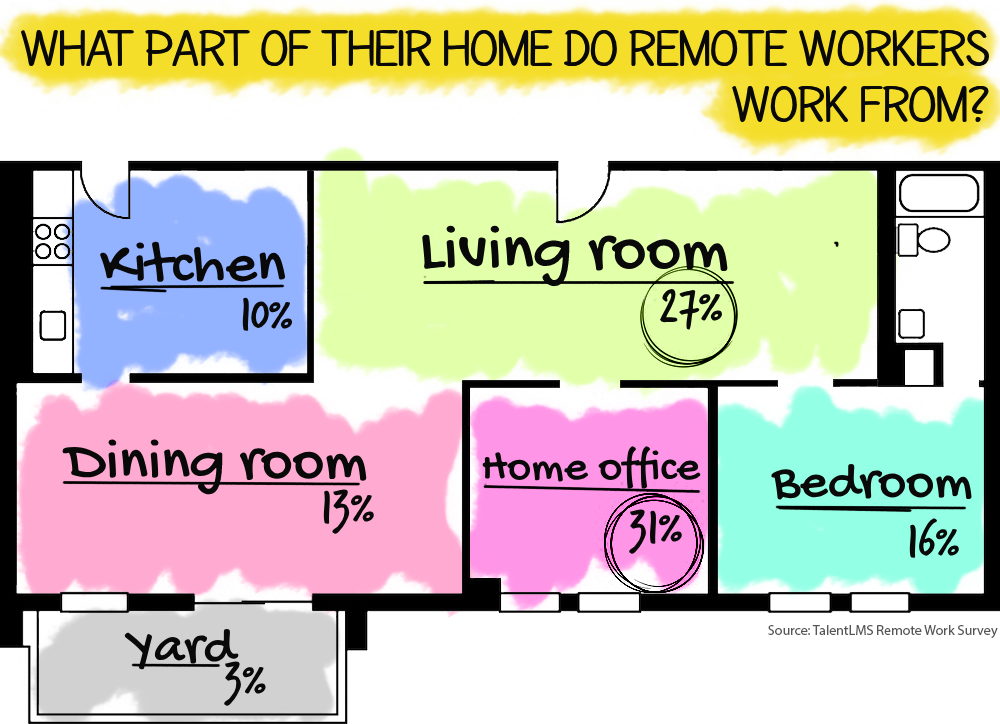The latest on all kinds of information, news, and resources that help you make working remotely better.
3 Ways Employers Can Optimize Hybrid Work | Michael Timmes, Forbes.com
Because hybrid work appeared in the business world so recently, most organizations continue to tweak their hybrid work programs to optimize the returns. Optimization of hybrid work will require organizations to focus on employee engagement and collaboration, place trust in workers and frontline managers and balance employee preferences with business needs.
1.Prioritize teamwork and high engagement.
Even within the same organization, different teams may have different optimal working environments. On teams where workers complete most of their work independently, one or two in-office days could be sufficient to promote collaboration and culture. However, other teams may work together frequently, making three in-office days necessary to maximize workflow.
To find that balance, HR teams should attempt to categorize roles across an organization as independent or collaborative. If the majority of an organization’s workers fall onto one side or the other, then the simplest solution could be a standardized hybrid schedule for everyone.
2. Rely on the judgement of workers and managers.
In general, employees want to perform at a high level, and managers want to help employees accomplish their goals. Many organizations may find it beneficial to implement a hybrid system, and those that do should listen to feedback and trust teams to make minor adjustments to their own schedules.
For example, an organization may set Tuesday through Thursday as designated in-office days. However, if a team realizes that Mondays in-office are more critical to productivity than Thursdays, management should be open to that experiment. There does need to be a process in place for any adjustments, so teams feel they are treated fairly. However, as long as each compromise has clear reasoning, employees often appreciate the added flexibility.
3. Keep business needs in mind.
Communication around schedules should begin well before employee onboarding. Recruitment teams should emphasize the requirements of the job from the beginning of the hiring process, including in online job posts. This will encourage candidates who feel comfortable with an on-location schedule to apply for the role.
Recruiters may fear that non-hybrid work schedules decrease competitiveness for job candidates. However, organizations should remain firm about the employee schedules necessary to support customers or clients. Even for employees, hybrid work is not everything. The same Gallup survey cited above also found that employees would not accept a salary reduction in exchange for work location flexibility.
Conclusion
By promoting engagement and collaboration, extending trust to teams and prioritizing business needs, organizations can manage hybrid work systems for optimal performance.
As companies push for a return to the physical office, the stress and anxiety of adjusting to a new routine can be overwhelming. Don’t let the transition catch you off guard – learn how to cope and thrive back in the office environment.
Dr. Haley Perlus, Sport and Performance Psychology Ph.D. offers these tips for making the transition back to the office.
Create a routine.
Establish a new routine that aligns with your work schedule, including a set time to wake up, have breakfast, and get dressed. This will help you mentally prepare for the workday and maintain a sense of structure.
Don’t ditch the workout.
It’s important not to let go of healthy habits like exercise that you developed while working from home. Exercise not only maintains overall health but also reduces stress and improves productivity.
Connect with colleagues.
As you return to the office, take the opportunity to connect with colleagues and build relationships. This can help foster a sense of community and make the workplace feel more welcoming.
Start meal prepping.
Meal prepping can be a game-changer when returning to the office after working from home. It helps save time, money and reduces stress by eliminating the need to decide on what to eat during the workday. Additionally, it can also promote healthier eating habits by enabling you to prepare nutritious meals in advance, ensuring you have access to healthy food options throughout the day.
Prioritize your mental health.
The transition can be overwhelming, so it’s important to take care of your mental health by practicing self-care and seeking support if necessary. Making time for activities like meditation, exercise, and therapy can help reduce stress and promote a healthy work-life balance.
Update your work space.
Adding plants, colorful décor, and comfortable accessories like a cozy chair or desk lamp can help create a more inviting workspace. Personalizing your work area can also boost morale and improve your overall mood and motivation while at work.
10 jobs with the most remote work opportunities | Diana-Ashley Krach, Stacker, Columbustelegram.com
Beyond productivity, employees report greater satisfaction with their remote work. That’s partly due to improved work-life balance. Research shows that more than 56% of remote or in-person employees can pause their work if needed. That flexibility, paired with remote employees no longer having to devote hours to commuting, makes telework very attractive. However, it’s still practical to note the potential obstacles, especially regarding technology. Creating a technology section on your resume can help hiring managers understand your ability to thrive with telework. For example, understanding the platforms that allow virtual meetings is essential to remote work.
Despite the challenges, many industries prove this can be a better work setting than standard offices. Keep reading to discover which jobs offer the most remote work opportunities.
#10 Project management specialists
Project management specialists help managers and their teams meet company baselines and goals. Some specialists have extensive knowledge of state and federal employment regulations and can examine an organization’s human resources procedures.
#9 Computer and information systems managers
Modern companies rely heavily on computers and internet communications and need them to be secure and reliable. Computer and information systems managers handle the details of keeping these vital machines and networks running smoothly.
#8 Lawyers
Not every lawyer spends all day in court. And even if they do, many civil court proceedings are now available through virtual platforms, making it easier for more lawyers to work remotely. Long before the pandemic began, one law firm launched with no physical offices; it is now one of the 200 top-grossing law firms in the country.
#7 Software developers
Software developers look at each piece of a software system like a puzzle, designing each section and determining how they fit together.
#6 Management analysts
A management analyst gets the call when a company needs an efficiency update. These analysts evaluate operations to help their clients boost revenue and reduce costs. Part of that process involves interviewing staff, which they can do remotely, along with reviewing the company’s financial records.
#5 Architectural and civil drafters
Those with an advanced degree in architecture, engineering, or construction management and a healthy dose of creativity may be well-positioned for remote work. Depending on a drafter’s experience level, a typical day might include developing detailed plans and drawings for commercial buildings and construction projects. Those projects can consist of essential highways and sewage disposal systems, and drafters must conduct extensive research about any technical aspect that could impact designs.
#4 Market research analysts and marketing specialists
Before an organization launches an advertising campaign, it brings on a market research analyst to save time and money. Analysts thoroughly research regional, local, and internet markets to determine a product’s or service’s viability. With that insight, analysts can figure out how well a product will sell or how a campaign will perform.
#3 Software quality assurance analysts and testers
Software quality assurance analysts and testers develop ways to look closely at software systems and identify problems. Through documentation of those defects, analysts can create a bug-tracking system and report any issues to web or software developers. Working with those developers closely, an analyst can review software designs and help plan for modifications and improvements. Because this job requires minimal supervision, it fits nicely into a remote work environment so long as the analyst can adhere to aggressive deadlines.
#2 Sales representatives, wholesale and manufacturing, technical and scientific products
Sales representatives of wholesalers and manufacturers possess specialized knowledge about how products and services can best benefit their customers. They also provide price quotes for products and services and generate contracts for purchases and sales. Building relationships is a big part of this job, which is why networking is integral.
#1 Web developers
Website developers build and maintain the functions and security of a site with regular tests, audits, and improvements. They are also responsible for communicating and coordinating with team members about content, visual presentation, and services provided on the website.
6 Employees Productivity Red Flags and How to Fix Them | Henry Smith, Techbullion.com
The team of employees is the most valuable asset in any organization. Employees react differently to the world around them. External and internal factors can negatively affect your team’s productivity. Organizing a team building activity can help every employee relax, bond, and accommodate each other for better productivity in the future.
Employees are constantly at loggerheads
It is not unusual for employees to disagree and see different issues from divergent points of view. However, when disagreements get in the way of meaningful criticism, it’s time to get your team outdoors. Conflicts can be between one department and another or between members of the same working group. A successful manager can recognize when in-house conflict management solutions are futile.
Outright lack of collaboration and communication
Teamwork helps the organization achieve more than each individual can. Better performance, therefore requires members to effectively communicate for members to consult, air their concerns and get reliable feedback for decision-making. However, if you realize your team deliberately refuses to relay information or work together, engage in a team building event.
Toxic work culture
A toxic culture can be lack of reliable communication, disorganized workflows, and unexplained delays. Sweeping red flag signals under the carpet finally catch up with the company’s performance. High staff turnover and constant burnout are likely consequences of unbearable work culture.
Low morale to work
A keen manager should notice when the employees’ morale is gone. While your team members may not always report 100% unmatched output every day, a significant drop in work morale is obvious. The usual lively chatter may turn into a damp silence cutting across the departments. Other times, members may show no excitement about learning new approaches or turning down opportunities to become more efficient at work.
A pattern of unending problems
Recurring issues that never seem to never get fully solved are a warning sign that all is not well with your team. Employees may feel like they’ve been warned or corrected a million times, indicating that more than mere talk is necessary. Team building activities can help improve poor collaboration, clarify company goals, and define the boundaries of one department from the others.
Undefined boundaries
When members lack responsibility, nobody would be willing to take responsibility or volunteer to do menial tasks around the office. Undefined position boundaries may lead to abuse of roles and overall poor performance.
Take away
Noticing the red flags of a demotivated team unravels communication and relationship struggles among employees in an organization. Outsourcing a team building event organizer can save your organization untold losses and poor performance.




























